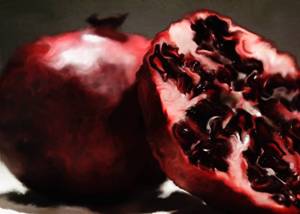Posted by: Kim_Hamilton on 02/22/2010 11:17 AM
Updated by: thepinetree on 02/22/2010 12:47 PM
Expires: 01/01/2015 12:00 AM
:

Growing Pomegranates~by Ken Churches
The pomegranate is associated with the most ancient civilization in the Middle East. Judging by some of the earliest records, the pomegranate is native to Persia and the surrounding area. It was also cultivated in ancient Greece and referred to by Greek writers several hundred years B.C., even before the advent of the almond, peach or apricot. Spanish missionaries brought the pomegranate to the New World soon after Cortez conquered Mexico in 1521. As the missions moved north to California, so did the fruits grown by the padres....

Pomegranates grow naturally as a bushy shrub or as a small tree-if trained, they may grow 15 to 20 feet high. The tree is quite resistant to cold when dormant , withstanding temperatures down to 10°F. The pomegranate is long lived compared to many other fruit trees-some trees have been reported to be over 200 years old.
The pomegranate can withstand long periods of drought. Although not much fruit is produced under drought conditions, trees will survive for years; then, if properly irrigated, they grow vigorously and produce good crops. To produce large corps of good-quality fruit, pomegranates require about the same amount of water and frequency of application as other fruit trees. Adequate soil moisture must be maintained throughout the growing season, particularly as harvest approaches in late summer and early fall, when it helps reduce the number of split fruit.
Pomegranate trees are not affected by any serious disease. The fruit, however, is frequently damaged by heart rot, caused by Alternaria fungus. Heart rot infection takes place in the bloom, and progresses to the interior of the fruit. The central cavity of the infected fruit is partially or totally decayed, yet the rind remains unaffected.
Trees may be trained to a bush, single- or multiple-trunked tree. The bush form is satisfactory for backyards or hedgerows, but is undesirable for good commercial production. Trees form the nursery are planted bare root in winter or early spring. The natural growth habit of the pomegranate is to produce many suckers from the base of the tree. If a single truck tree is desired, only one vigorous sucker or the trunk of the original nursery tree should be selected and branches grown from it. Basal suckers should be removed periodically to promote growth form the main trunk of the newly planted tree. Pomegranate trees require a small amount of pruning each winter to maintain shape and good bearing surface. Even mature trees grow vigorously, sending up a large number of shoots and basal suckers that require removal each year.
Picking begins in August before fruit is fully mature. The fruit is widely used for decorative purposes, but is also eaten fresh. Children especially enjoy breaking fruit open and eating the kernels. Chefs commonly use the kernels as a garnish for desserts and salads-for a real treat, kernels may be rolled in small cream cheese balls to be served as appetizers. Perhaps the most popular use for extracted juice is in making pomegranate jelly.
This article adapted from Cooperative State Research, Education and Extension Service, USDA. Please contact the Farm Advisor’s office at cdcalaveras@ucdavis.edu or 754-6477 with your agricultural questions. Talk to a certified Master Gardener every Wednesday, 10:00-12:00, 754-2880.
|

